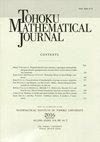Lorentz-Minkowski空间${\mathbb R}^{n+1}_1$中具有边界的类空间图形超曲面的各向异性逆平均曲率流
IF 0.4
4区 数学
Q4 MATHEMATICS
引用次数: 8
摘要
本文研究了在$(n+1)$维Lorentz-Minkowski空间$\mathbb{R}} {n+1}_{1}$中中心原点半径为1的双曲平面$\mathscr{H}^{n}(1)$凸块上沿具有消失的Neumann边界条件的各向异性逆平均曲率流的类空间图形超曲面的演化,并证明了该流一直存在。此外,我们可以证明,经过适当的重新缩放后,演化的类空间图形超曲面平滑地收敛到原点中心和规定半径的一块双曲平面上,这实际上对应于在$\mathscr{H}^{n}(1)$块上定义的常数函数。显然,这个结论是我们之前工作的延伸。本文章由计算机程序翻译,如有差异,请以英文原文为准。
An anisotropic inverse mean curvature flow for spacelike graphic hypersurfaces with boundary in Lorentz-Minkowski space ${\mathbb R}^{n+1}_1$
In this paper, we consider the evolution of spacelike graphic hypersurfaces defined over a convex piece of hyperbolic plane $\mathscr{H}^{n}(1)$, of center at origin and radius 1, in the $(n+1)$-dimensional Lorentz-Minkowski space $\mathbb{R}^{n+1}_{1}$ along an anisotropic inverse mean curvature flow with the vanishing Neumann boundary condition, and prove that this flow exists for all the time. Moreover, we can show that, after suitable rescaling, the evolving spacelike graphic hypersurfaces converge smoothly to a piece of hyperbolic plane of center at origin and prescribed radius, which actually corresponds to a constant function defined over the piece of $\mathscr{H}^{n}(1)$, as time tends to infinity. Clearly, this conclusion is an extension of our previous work [2].
求助全文
通过发布文献求助,成功后即可免费获取论文全文。
去求助
来源期刊
CiteScore
0.80
自引率
0.00%
发文量
22
审稿时长
>12 weeks
期刊介绍:
Information not localized

 求助内容:
求助内容: 应助结果提醒方式:
应助结果提醒方式:


